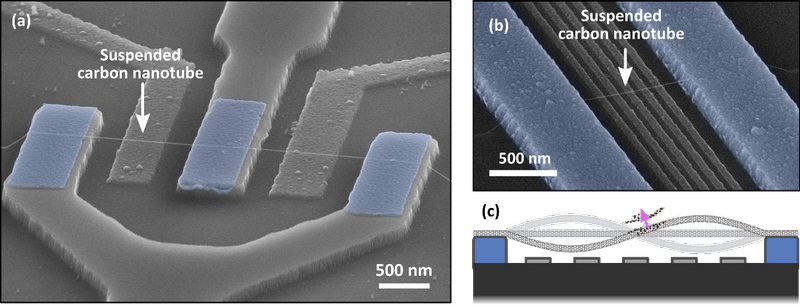Carbon nanotube quantum circuits for nanomechanical experiments
-
Job Type:
PhD
- Contact Person:
Context: The last two decades have seen fast progress in the research field of nano-mechanical resonator [1], enabling to use these systems to study quantum mechanic at the scale of a single quanta. The recent advances in this field such as Schröndiger cat mechanical states [2] or entanglement between distinct resonator, offer great promise in the context of quantum computing. Among the various physical implementations of nano-mechanical resonators, a carbon nanotube is a very attractive candidate. Thanks to their small dimensions (diameter of 1-4nm) they possess very high resonance frequency (from 50MHz to few GHz), and very large quality factor (up to few millions).
In our group we developed a custom nano-assembly technique [3] to fabricate a new generation of quantum circuit based on a pristine suspended carbon nanotube. This new technique allows to combine carbon nanotube circuit with other technology in order to realize hybrid system. For instance, we can integrate a carbon nanotube in complex superconducting microwave circuits opening a broad range of experiments. It is also possible to graft a single molecular magnet (SMM) on a carbon nanotube, thus realizing an ideal work-bench for investigating spin-phonon coupling at the quantum level, with for instance the observation of the Quantum Einstein-de Hass effect [4].
Within this framework, we propose two PhD projects. One on the realization of a Superconducting Quantum Interference device (SQUID) based on a carbon nanotube for optomechanics experiments. The second project focus on the study of spin-phonon and electron-phonon coupling in a double quantum dot circuit inside a suspended carbon nanotube. Both type of circuit can be used as single molecular magnet quantum sensor

Fig.1: (a) SQUID-circuit built out of a suspended carbon nanotube using our custom nano-assembly technique. (b) Double quantum dot circuit. (c) Schematic of a vibrating carbon nanotube with a built-in double quantum dot coupled to single molecular magnet.
Work plan: Both projects are constituted of different experimental phases. This first part will consist in the nano-fabrication of the circuit including numerous cleanroom fabrication techniques. The main part of the projects will be the mK temperature measurement of the circuit thanks to our cryogenic setup. These measurements include low-frequency transport techniques (DC and lock-in measurements) as well as microwave measurements of the nanomechanical resonator, and the single molecular magnet.
Reference:
[1] Mesoscopic physics of nanomechanical systems A. Bachtold, et al., RMP (2022).
[2] Schrödinger cat states of a 16-microgram mechanical oscillator. M. Bild, et al., Science (2023)
[3] Nanoassembly technique of carbon nanoubes for hybrid circuit-QED T.Cubaynes, et. al, APL (2020)
[4] Quantum Einstein-de Haas effect, M. Ganzhorn, et al., Nature Communication (2016)

